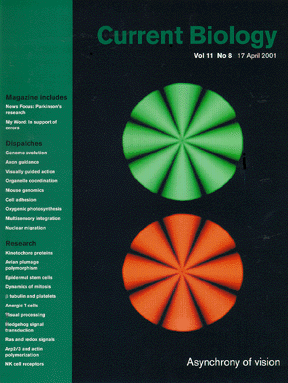
The movie above shows a stimulus oscillating in both direction and colour. If asked, most people say that this stimulus is rotating anti-clockwise while it is green. In fact, while the stimulus is green it rotates both clockwise and anti-clockwise for equal periods of time. Why don't observers report this?
Bartels and Zeki (1998) have recently proposed a modular theory of visual awareness. The theory makes the following assumptions...
1. Different stimulus attributes, such as colour, form and motion, are
processed within different perceptual systems.
2. Each of the different systems independently mediates our perceptual
experiences of the attribute for which it is specialized.
3. As our experiences of colour, form and of motion are mediated by independent perceptual systems, any process that brings these attributes together (so that we can see bouncing red balls) must bring together activity that has already been perceived. There is no final stage of processing where everything is brought together before you can have a visual experience.
My collaborators and I have addressed these proposals in a series of studies. We have found some evidence for asynchronous processing between colour and motion. We demonstrated, using an indirect measure of visual processing, that the physical correlation between two stimulus attributes can differ systematically from their perceptual contingency.

We have also shown that the extent of the perceptual advantage for colour, relative to motion, varies as a function of the difference between the contrasted directions
and that the optimal conditions for pairing specific colours and motions arises when colour changes are delayed relative to direction changes
The apparent perceptual asynchrony between colour and orientation appears to be somewhat different. We have shown that this asynchrony depends critically upon the task that the observer is required to complete.